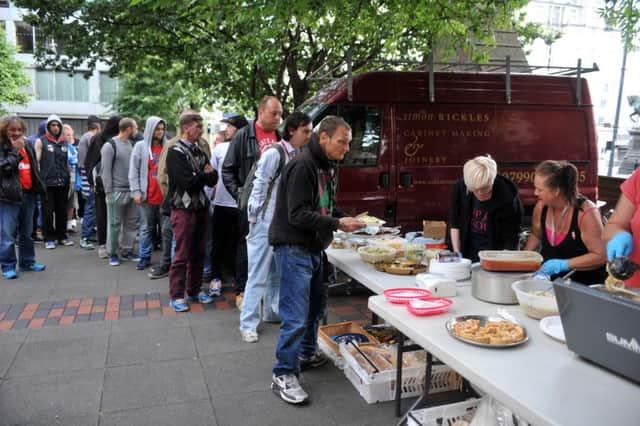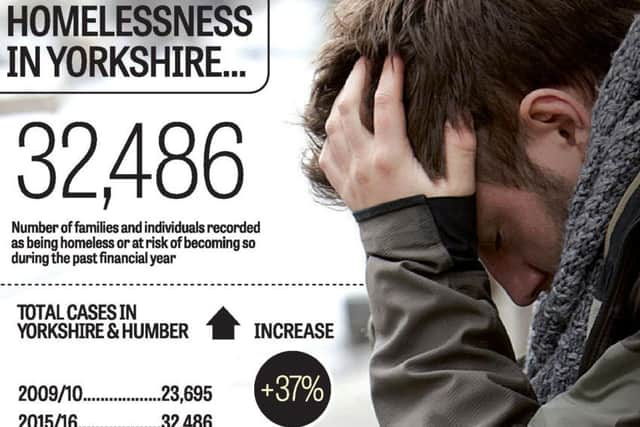Exclusive: Homelessness in Yorkshire even worse than height of recession


More than 32,000 families and individuals were recorded as being homeless or at risk of becoming so during the past financial year, a rise of 37.10 per cent since 2009/10.
As councils and charities are expected to do more for less, The Yorkshire Post can reveal local authorities in the region handled more than one in 10 of all cases in England during 2015/16.
Advertisement
Hide AdAdvertisement
Hide Ad

Brian Robson, policy and research manager for housing at the independent Joseph Rowntree Foundation, said: “The Yorkshire Post’s figures on homelessness in the region are startling, but broadly consistent with the increase in homelessness caseloads right across England in recent years.
“We can solve homelessness, but it will take action from government, councils and housing providers.”
Our figures bring together data from the Office for National Statistics on rough sleepers, households meeting statutory criteria for being homeless and in priority need, and action taken to prevent and relieve homelessness by local authorities.
Advertisement
Hide AdAdvertisement
Hide AdIn 2009/10 the homeless cases total in the region stood at 23,695, with the vast majority being prevention and relief work. There were 115 rough sleepers, 3,800 people classed as being statutory homeless and 19,700 prevention and relief actions.


But long after the recession was said to have ended, the level of people in need has continued to rise. The total in 2015/16 was 32,486 – an increase of more than a third on 2009/10 and more than the national rise of 32.34 per cent.
Figures show the number of rough sleepers had risen to 157 and actions for prevention and relief were up at 29,302, but those classed as being statutory homeless had fallen to 3,027.
Mr Robson said: “A good start would be for England to adopt the more prevention-focused approach used in Wales – where people get real help before they lose their home. We also need to get building: we need far more homes, and this must include an adequate supply of decent, secure rented housing.”
Advertisement
Hide AdAdvertisement
Hide AdThe regional figures show prevention and relief was the greatest area of growth, rising by 48.74 per cent over the seven years.
In Leeds, Yorkshire’s largest city, the council recorded a staggering 226.87 per cent increase in its prevention and relief actions.
Leeds City Council attributes part of this increase to the proactive approach being taken.
While rough sleeping has increased since 2009/10, the number fell from 15 in 2014 to 13 people in 2015.
Advertisement
Hide AdAdvertisement
Hide AdA spokesman said the issue of homelessness was a priority, and it worked with other organisations to ensure there were beds for those who would accept them.
“A proactive approach is in place to prevent homelessness, and it is positive news that this is working,” he said. “We are the only Core City to see a reduction in the number of rough sleepers over the past two years.”
By contrast, York saw rough sleeper numbers rise from 13 in 2014 to 18 in 2015. There were just two people in 2010.
City of York Council’s Head of Housing Services, Tom Brittain, said: “Unfortunately, despite ongoing work, the commitment of agencies, continued resources and new flexible methods of working, the number of rough sleepers in York rose.”
Advertisement
Hide AdAdvertisement
Hide AdHowever, the city has reduced statutory homelessness, with a 30 per cent fall since 2010/11.
Of the six local authorities with cities studied by The Yorkshire Post, only York and Wakefield saw decreases in total homelessness case work.
Maeve McGoldrick, head of policy and campaigns at single homeless person’s charity Crisis, said: “More and more people are struggling to pay their rent in an increasingly insecure market, while cuts to housing benefit and local council funding have left the safety net in tatters.
“The Homelessness Reduction Bill, soon to have its second reading in parliament, would require all councils in England to take action to prevent people from becoming homeless.
“It offers an historic opportunity, and if passed, would represent one of the most important developments for homelessness in nearly 40 years.”